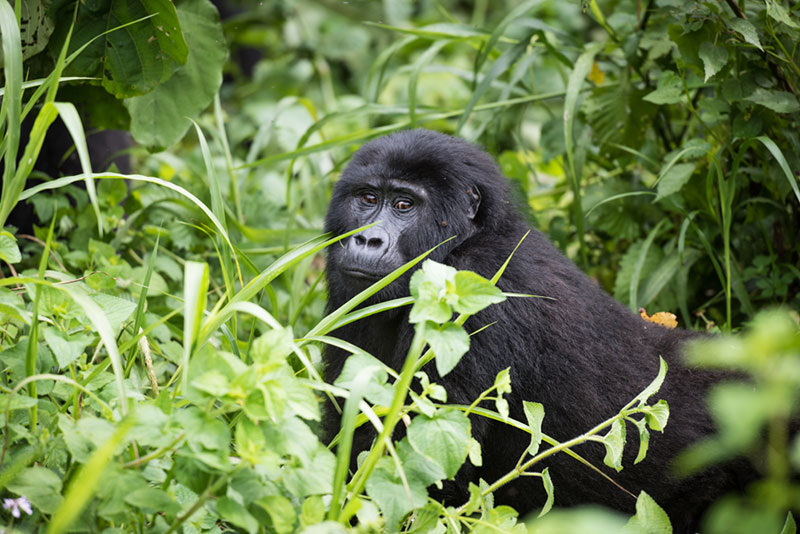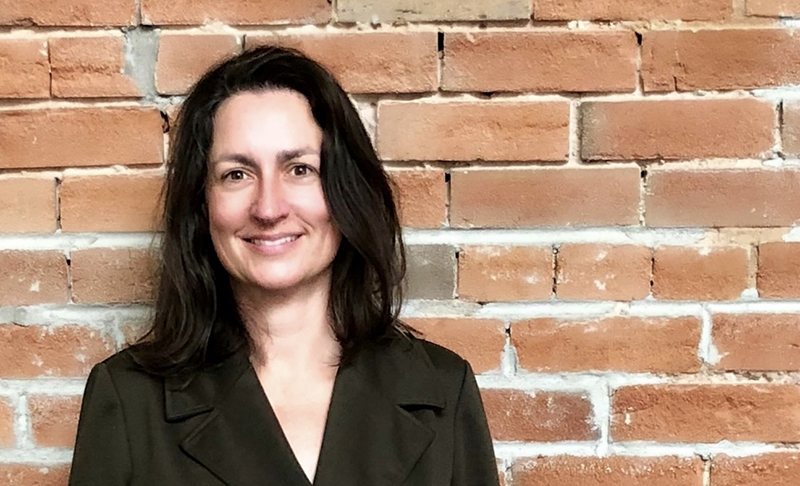
Francine Madden ©Center for Conservation Peacebuilding
Twenty-five years ago, Francine Madden finished graduate school and set off for Uganda’s Bwindi Impenetrable National Park, where she had secured a job addressing community conflict related to mountain gorilla conservation. Mountain gorillas, particularly those that had been habituated to people for tourism, were moving into villages, raiding crops, and occasionally attacking people. This impacted the villagers’ ability to go to market to sell their crops and wares. Although the Park had created community schools and health clinics as part of a benefit sharing program, many villagers were too afraid to leave their homes to access them. Frustrated villagers began retaliating by poaching gorillas. Meanwhile, gorillas were contracting diseases from humans. Madden quickly recognized that no one was winning this conflict and that a “giant gulf” existed in the park’s approach to resolving it: the people at the core of the conflict were not included in the decision-making process. When she began to bridge that gulf by creating a more fair and inclusive process, she discovered that beneath this human-wildlife issue existed a much deeper, identity-based conflict. Looking across the conservation field, she saw identity-based conflicts as key characteristics. That realization led her to apply the peacebuilding model of conflict transformation. This model seeks to transform the complex root causes of conflict in to opportunities for constructive change for people and conservation. She has been building upon that pioneering work and the growing practice of Conservation Conflict Transformation (CCT) ever since.
Now the Co-Founder and Executive Director of the Center for Conservation Peacebuilding (CPeace), Madden has helped strengthen conservation efforts around the world by using controversial fish and wildlife conflicts as entry points to target the deeper-rooted, systemic conflicts that underpin natural resource challenges. CPeace offers capacity building, strategic guidance, and conflict assessment and intervention to help people reconcile identity-based conflict, transforming decision-making processes. Her work through CPeace has resulted in long-term, positive, creative solutions for government agencies, diverse stakeholders, and interest groups around some of the world’s most controversial, polarizing, and complex conservation challenges.
Let’s talk a bit about your experience in Uganda. What led villagers near the park to start poaching mountain gorillas?
It is hard to retaliate against a government or conservation authority, but you can retaliate against the wildlife species that they are seeking to protect. This is not unique to the situation with mountain gorillas in Uganda. It’s a form of protest and expression of frustration and anger. The people who do this are not bad. They don’t want to be criminals. They just feel like they have no way of having their voice heard. This is where the process piece comes in. People at the heart of the conflict don’t have to like the wildlife, but if they are included in a process that gives them a voice in the decisions that affect them, they can coexist with the wildlife because they’re getting their needs met and they have have voice in a shared problem solving effort.
How important are relationships in conservation conflict transformation (CCT)?
When I first started in Uganda, I was more interested in solving the problem, but to me it was just good practice to ensure that the process was fair, inclusive, and worked on relationships. If you have bad relationships, how are you supposed to make really big decisions together? How are people supposed to take a risk? How are people supposed to be creative if they don’t like, respect, or feel respected by the person with whom they are making decisions?
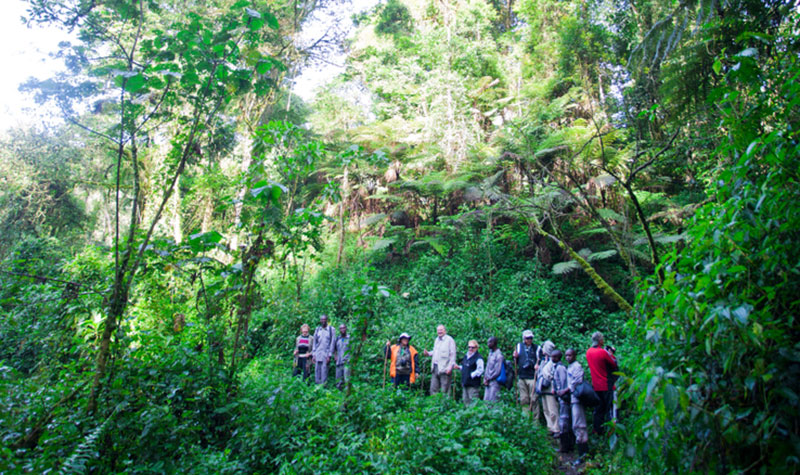
Tourists in Uganda ©Travel Stock/Shutterstock.com
If you can address the process and relationship aspects of conflict, then the wisdom, experience, creativity, and capacity of the people in the room is phenomenal. It never ceases to both humble and inspire me to see what people are capable of when they’re in a process that really focuses on reconciling deep-rooted identity conflict; a process focused on creating the space for them to deeply analyze what’s going on in that conflict and come together in a creative way to solve each other’s problems essentially.
In your paper “Conservation’s blind spot: The case for conflict transformation in wildlife conservation,” which was published in the journal Biological Conservation in 2014, you wrote, “Even as the conservation field moves toward more collaborative governance models of engagement…too often the processes used…fail to recognize or reconcile the deep-rooted conflict among stakeholders, and as a result, conservation goals are hindered.”
Based on your experience, what do you consider the top three explanations for this shortcoming?
First, the conservation field is focused on the wildlife, the biology, and the ecological system. That’s where conservation researchers, and practitioners, and students are taught to focus, and that’s where the expertise is.
Are you saying that there is a lack of recognition or understanding of the human’s role in the ecosystem?
The recognition of the human comes in the form of looking at the human’s values or attitudes toward the resource, but that doesn’t address what is going on between individuals and groups of humans. If we fail to look at the complex social system in which decision-making takes place, then the process–even if very well intentioned–can be a bit like trying to ram a square peg into a circular hole.
The second explanation is that popular, mainstream approaches–such as conflict resolution, alternative dispute resolution, interest-based negotiation–weren’t designed for deep-rooted, complex social conflict in natural resource decision-making. They all rest on focusing on the substance, trying to move off positions, and getting down to common interests. But if you have an underlying us-versus-them conflict, where each side feels like they are being annihilated, these approaches are not effective. In the natural resource realm, you often have uneven power dynamics. The more traditional, linear ways of approaching conflict and decision-making were not designed for the complexity of social conflict we find in conservation or natural resource management today. CCT needs to be nonlinear in order to be responsive to the dynamic social systems that we’re in.
Another thing that’s different about conflict transformation is that it looks at conflict as a normal part of what it means to live in a human community. You don’t get rid of it. It’s something that you’re continually transforming. At its heart, conflict transformation is about taking the energy from destructive conflict and transforming it into a positive, constructive opportunity for change while recognizing that conflict is going to keep coming up. So how do you anticipate and constructively address that going forward? The third reason [for the shortcomings of traditional conflict resolution in conservation] is fear of loss – loss of control, loss of way of life, loss of endangered species. Everybody feels like they’re already losing so much, and there is a great fear of losing control. That fear creates an initial resistance to sharing power and engaging.
Conflict transformation is about going deep, wide, and long. Going deep means going down to reconciling that us-versus-them conflict. Going wide means designing a process for that time, that context, and that system, in which those decisions have to be made. It also means engaging in a way that minimizes or prevents unintended negative consequences. Going long means recognizing the need for long-term resilience, stability, and sustainability. You’re not talking about going to a car dealer and trying to negotiate for a car. That is a snapshot in time, and you don’t need the relationship piece. If you’re negotiating for a car, you get your car, they get the money, and you walk away. You could hate each other, and that’s okay. But if you’re talking about conservation or restoration, you’re dealing with government institutions, conservation organizations, businesses, and communities who are all in it for the long haul. There is usually a history behind them, and there needs to be a future in front of them. You need a process that actually has a mid- to long-term view. That also means embedding the capacity in the people in that system to continue to transform conflict.
I recognize that the nature and context of every conflict situation is different, but is there a general step-by-step flow to the process of going deep, wide, and long?
Conservation is rooted in science, where there is a desirability to have replicable processes, but conflict transformation does not rest on a “step one, step two, step three” approach. It rests on a set of theories, principles, processes, and skills, and upon building the capacity of the practitioner to be responsive to the dynamic system they’re in. You will lose the capacity to be responsive to that dynamic system if you’re trying to follow a checklist. We’ve shown that CCT is a proven model, but it’s a model that is responsive to the conditions you’re in. Underlying human neurological and psychological factors and as well as social system patterns emerge no matter where you are on Earth, but every context is unique. The process you design needs to be responsive to each specific context, set of issues, and point in time.
That said, you always begin with an analysis of the conflict dynamics. Conservation practitioners will often analyze the biological or ecological conditions, or people’s attitudes about wildlife or a specific solution, but not the social conflict dynamics. Only by analyzing those social conflict dynamics do you know where and how to intervene. Analysis always comes before intervention. It is very important to start with individuals on all sides of the conflict. They provide the wisdom and the insights that help you determine what kind of process you need to design. This requires an awareness that there is often conflict within, not just between, groups. Conflict between groups can often fuel destructive conflict within groups and vice versa. You can have this vicious cycle, which is very typical. When a conflict is particularly destructive or seemingly intractable, that’s a red flag that you’re not just dealing with an us-versus-them conflict, but an us-versus-us conflict. In that case, you must first address the same side conflict, and then address that multi-stakeholder decision-making or conflict.
Is that when the relationship building comes in? Is that when you begin reducing the fear and the vilification of the other?
Yes, you have to build receptivity. From a neurological standpoint, you cannot remove emotions from decision-making, so you have to ask yourself what kind of emotions are more likely to be receptive to rational arguments and get you the creative, shared problem solving that you need. Those are positive emotions. It is essential to ensure that you’re giving enough weight and care to the substance, the process, and the relationships. In conservation, they often do a lot of analysis of the substance and become very problem focused. Then they put in place a process and say, “Yeah sure, we’ve got some level of trust here.” In those cases, what lacks is the quality of both the process and the relationships. If you’re building a three-legged stool, and you put a lot of energy into making the substance leg strong and stout, but you put toothpicks under the process and the relationship legs, when you go to stand on the stool, it will fall over. This might make you conclude that three-legged stools don’t work, but the problem is that those two legs didn’t get the sophisticated attention that is essential for long-term resilience. The process and relationships are really what gives you the capacity to adapt or develop new solutions when new problems arise.
“…merely addressing the dispute level of conflict is equivalent to trying to put a cap on top of a volcano.”
Your 2014 article in Biological Conservation references three levels of conflict: the dispute (the tangible manifestation of the conflict), the underlying conflict (the history of unresolved disputes), and identity-based/deep-rooted conflict (the social-psychological needs central to the identity of at least one party). Can you talk about how CCT works at all three levels?
As a third party neutral my mandate will often be the issue, the dispute. However, much like a volcano, it’s the energy that comes from the deeper conflicts that cause the explosion, and merely addressing the dispute level of conflict is equivalent to trying to put a cap on top of a volcano. However, a very positively centered, relationship focused CCT process will allow for the reconciliation of those underlying conflicts, and deep-rooted identity-based conflicts and create the conditions for participants to collaboratively and creatively solve problems together. That’s how you address all three levels of conflict. If your process isn’t designed to address all three, you get a temporary solution at best, and things often immediately or eventually fall apart.
To be effective, must CCT be implemented by a third party neutral?
You do not require a third party neutral to deal with most conflicts that are out there. Some require it because the conflict has gotten so destructive. But with even the most destructive, seemingly intractable conflicts, the best people to transform the conflict are the people within that system. The issue is getting them the capacity to do that. At CPeace, we spend a large portion of our time building the capacity of people –whether they’re in a government agency, an NGO, a company, or community–to transform their own conflict. Insiders know that system best and they are going to be there throughout time. They have skin in the game. Most of our great success cases are by people who have gone through one of our five-day capacity building workshops, and then gone out and done amazing things.
“Why would anybody get on board with a conservation action if the conservation entities aren’t meeting the community needs?”
Your work on the conflict over wolves in the state of Washington demonstrates that human-wildlife conflict can be less about the animal than a deep-rooted identity-based conflict among different groups of people. Can you share another example of a conservation conflict underlain by a deep-rooted social conflict?
I did an intervention for an ecological restoration effort involving the eradication of the invasive rats on an island in the Galapagos. It involved government agencies, conservation organizations, and landowners, which is typical in natural resource conflicts. The eradication would have required enormous motivation–both up front and in the long term–on the part of the local community. First, they’d all have to leave the island [temporarily for the initial eradication]. Then, in order to maintain biosecurity, they’d have to keep the rats off the island, which would require a change of behavior of everyone on the island because they have boats going back and forth all the time. If one male and one female rat came onto the island after the big intervention, all of that effort is gone. With this particular kind of ecological restoration, if you don’t have 100% success, you have 100% failure. I was thrilled by the challenge of needing 100% success!
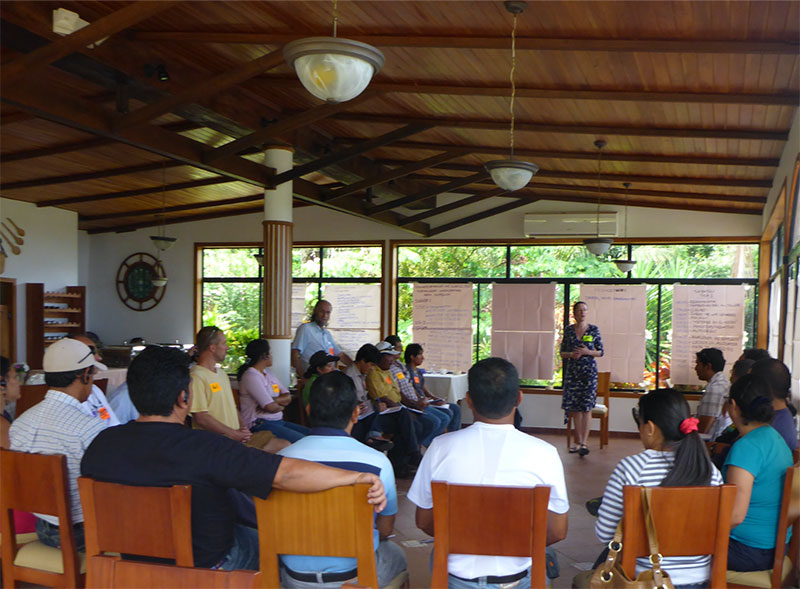
Madden at work in the Galapagos ©Center for Conservation Peacebuilding
For years and years, the community had been unanimously opposed to the restoration, and I was asked to do an intervention. I discovered [through the CCT process] that the root of this conflict was power imbalance: between islands and between people with title, or status, or education and those without. We also had a perception issue. So often, the conservation agenda is perceived as a bigger priority than the people. In this case, there was a perception that the conservation and government organizations cared more about a tortoise species and endemic birds than the people on the island. The local community was being asked to take on a huge lift for conservation, but their needs weren’t being met and their identity was under attack. They were not recognized for their contributions on their island, and they felt like their cultural, economic, and physical security was threatened. People had basic human needs related to identity, recognition, and meaningful participation in decisions that were not being met. If you enter into this dispute and say, “We need to restore the ecology of this island through invasive species eradication. Can you get on board with us?” you will have a volcano of deeper-rooted conflict, and your unintentional message becomes, “Hey, come meet our needs, but we don’t care about yours.”
Why would anybody get on board with a conservation action if the conservation entities aren’t meeting the community needs?
The CCT process not only helped all sides discover and unpack the deep-rooted conflicts but it helped them address their own conflicts and needs as well. At the end of the process, the community, government agencies, and conservation groups all came to 100% consensus on a plan that would address both conservation and development needs of the island. It’s a long-term multi-year process, and they have maintained their shared momentum, commitment, and collaboration over time.
What were some of the tools you used in this case to help build relationships once you unearthed the deep, underlying conflicts?
I don’t want to get checklisty, because what I did there would look different somewhere else, and my mandate was highly limited to a really short period of time, so not only would the process be designed differently in different contexts, but this one didn’t even provide me the opportunity to implement best practices! That said, it worked and continues to work, even six years later. I started with the individual conversations with everyone who was going to be part of the process, as well as ensuring we had all the key people in the room. Then, we brought people together in a positively centered process that included capacity building. The multi-stakeholder portion of this intervention was a five-day workshop involving all the key leaders, individuals and groups in conflict within one another. We started with capacity building in CCT, then had them analyze the conflicts going on in their own world. This gave them all a shared understanding of the deeper drivers and complexity of these conflicts. It gave them, collectively, a 360-degree understanding of the conflict. Once people understood their role in the situation, knew how to transform conflict, and even had fun with one another, they were much more effective at addressing their conflict and maintaining the motivation to continue transforming it, making progress, and adapting solutions to solve problems.
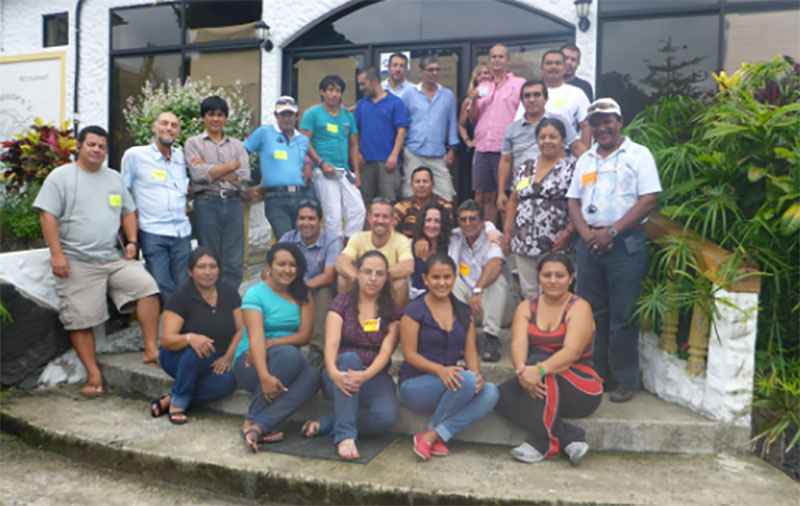
Building capacity and transforming conflict in the Galapagos ©Center for Conservation Peacebuilding
The research on decision-making processes shows that if you have a good decision-making process with diverse viewpoints and groups involved, they will come up with much better solutions than any one entity or side on its own. Furthermore, lacking viewpoints can lead to overlooking potential unintended consequences. You can’t really solve a problem unless you have a 360-degree understanding of that problem, and you can’t have that if you don’t get all of the diverse viewpoints in the room.
Once they had gone through the capacity building, and had analyzed their own conflicts, they went through a planning process to look at how they could “expand the pie.” They discussed all the things they wanted to do, both from a conservation and sustainable development side, and they created a more wholistic, comprehensive plan for what they wanted to do. That’s what they have since been marching forward on together. The whole effort took about five months, with two weeks on the ground. That investment has paid off now for six years running.
Larry Susskind of MIT and the Consensus Building Institute recently spoke with us about the use of role-playing/serious games as a way to help individuals from different stakeholder groups better understand the “other” and enhance their capacity to solve problems collaboratively.
He’s absolutely right. Role-playing is a big part of our capacity building work, but you can’t necessarily do that with every group or culture. In the Galapagos case, it worked. In some cultures, it may not. That said, getting people to have fun and laugh together is powerful in every context and role-playing can be a great way to have fun and create empathy on all sides.
You’ve shown in the Galapagos example that CCT can apply to ecological restoration. What about conflict in regenerative or sustainable design? Is there a limit to the use of conflict transformation?
Conflict transformation can absolutely apply to regenerative design. It has broad applicability. Conflict transformation came from a niche within the peacebuilding (war and peace) field. Its only limit is if you don’t need people to make decisions or if people won’t be impacted by decisions made, which rarely happens. But if you have human communities with different values, interests, identity groups, and power dynamics, and preconceived notions that each side might have toward the other, it applies. I’ve even used it in my daughter’s previous school to help address a racial conflict within the school. If you’ve got humans, you can apply CCT. CCT also helps groups and projects prevent conflict. You don’t need to wait until things are bad before you do the right thing to ensure high-quality relationships, resilient processes and creative, sophisticated problem-solving!
Many of our readers engage in adaptive management and recognize the need to learn, as our disciplines grow and evolve. CCT itself sounds like an adaptive management process, but in your application of it, have you experienced any failures or stumbling blocks that have taught you great lessons and informed the practice?
CCT is a valuable approach to set adaptive management up for success. In conservation, it can be so hard to come to a decision the first time, and even though everyone said they’d do adaptive management, they end up not doing it because of the pain they experienced getting to a decision the first time around. People are understandably afraid of having to get back in the room in that destructive conflict setting, and their perception is they have to negotiate again and might lose something. With its emphasis on capacity building, CCT is a wonderful complement to the philosophy and the desire of adaptive management.
“Much like your own health, peace has to be maintained, and it takes work.”
But to answer your question, the first failure had to do with my first case in Uganda. I was very focused on the technical solutions, and to me the process and relationship stuff was just good business. Everybody had been a part of the process and thought it was phenomenal. Well, when I left there, I had put together a plan for managing the land in a way that would keep mountain gorillas and people apart, but I did not make it explicit that you have to maintain focus on the process and relationships. If you just focus on the substance, it will fall apart. So, failure number one was not being absolutely explicit and intentional about the continuity of effort on the process and relationship aspects of problem solving and conflict transformation.
I don’t know if this is a corollary or a number two, but the effort to sustain peace has to be maintained. It’s less work to maintain the peace, but it still needs attention and work. I once had a brief opportunity to work on a destructive conflict between a government agency and a couple conservation NGOs. While their reconciliation and progress together was incredible, their efforts weren’t supported by the government leadership so it was pretty rough for a while. What happened was this: A middle manager from the government agency was central to the process, but he was also the only person from his agency involved. When the two groups (government and NGOs) reconciled and began working incredibly well together, they knew this could all fall apart if the government leadership didn’t make this effort a priority. Indeed, the leadership saw the amazing change, but instead of recognizing the need to support its continuation, they said, “Great! Now that that’s working, we’re pulling you, middle manager, off of this project and onto these other things.” Now, think about all of the energy that has to go into making war or destructive conflict. When you transform that and achieve peace, you can’t just sit on it or ignore it or cross your fingers and hope it stays. It has to be nurtured and maintained through time. What if you got into great physical health by exercising and eating well, but at age 40, you said, “I’ve done it!” and proceeded to park yourself on the couch and eat bonbons for the next three decades? Much like your own health, peace has to be maintained, and it takes work.
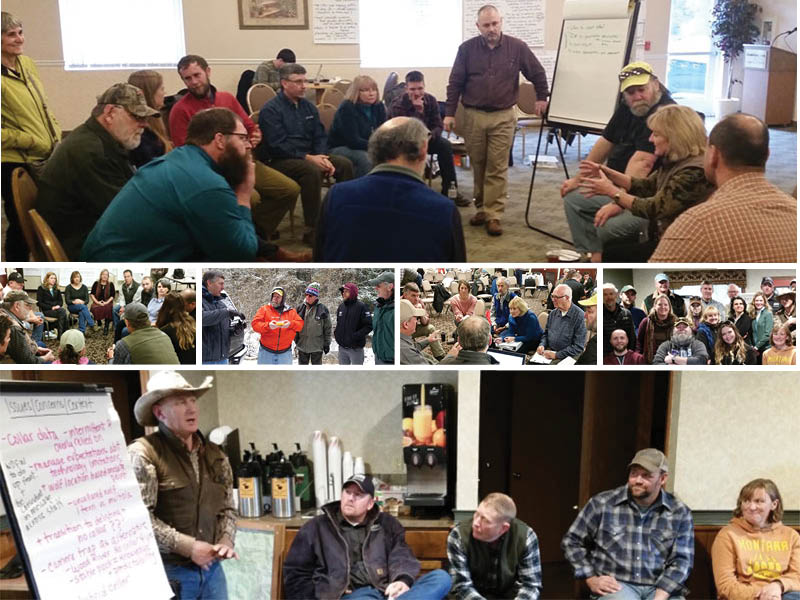
CPeace working with the Wolf Advisory Group citizen committee that advises the department on wolf recovery and management ©Center for Conservation Peacebuilding
As we become more polarized as a society, the outer edges of extremism can be a challenge to CCT. People often mislabel others as extremists, or think of extremists as spoilers, but they are not. I have seen so-called extremists come in and radically adhere to and be part of constructive, collaborative problem-solving because they recognize that their needs will be better met through this CCT process than outside it, using their old tactics. That said, a very, very few people or groups may be more tied to a position of permanent opposition or tied to using fight tactics as part of their mission, rather than to getting to desired change. This kind of extremist group gets smaller and smaller in a CCT process, because most of the individuals and groups who might have looked extreme before from the other side’s point of view move toward a more collaborative, transformative approach to getting their needs met. But this very small percentage on the outer edges of extremism who don’t ever want to move may feel their identity is under threat because now they’re an increasingly smaller minority, and in some of those cases, they could become more reactionary. There are strategies to address that level of extremism, and the intervention needs to match the severity of the conflict, but it’s definitely a challenge.
You mentioned the CPeace’s capacity building workshops. What are some of the other resources you offer to people who want to improve their skills in this area?
As a matter of fact, we have a public capacity building workshop coming up in October, and it’s open to the public. We also offer private workshops and many levels of capacity building, whether it is helping get people get on the right track or doing a full-blown intervention. We also offer personalized web-based learning and strategy seminars and are working on building some web-based resources, but when you’re talking about social conflict, experiential, face-to-face, collaborative learning can’t be beat. We are also doing more monitoring and evaluation as part of our work to build the field and these resources will be shared widely.
We are a nonprofit that is largely fully funded through fee-for-service activities. That means most of our time is spent doing that work. The demand is huge, and our ability to meet that demand is limited. As an example, we did a public capacity building workshop last year. Through our very, very small donor base, we were able to offer a few scholarships for people to come to the workshop. We put out a notice about the scholarship application process, and in a matter of days, we had 130 applications from 49 countries.
And now that coronavirus is having a significant impact on our in-person work, we’re going to pivot to meeting client needs through web-based capacity building and strategic guidance so we can continue to help folks out there achieve their goals.
Given the current social climate and its permeating polarization, it seems like the services you offer are so needed. How can people support the work of CPeace?
You’re right! Demand is incredibly high, but the funding to provide these critical services is lacking. But your readers can help – there is a donate button on our website (www.cpeace.ngo). And here’s why we need support:
CPeace is seeking to scale up our reach and our impact. While we’ve been operating as a fee-for-service non-profit, too many professionals and projects in need can’t afford our services and we don’t have the funding to provide them for free. This is why we’ve developed a scholarship and crisis fund – to help those in need, even when they don’t have the funds. This is a critical area where people can help us help others to achieve our mission so people, wildlife, and ecosystems thrive! And there’s a ripple effect impact that is far-reaching even when we build the capacity of one individual. One person can share that capacity with their team and partners and transform their impact on the ground. They can design and implement projects that not only achieve better results for all, but also prevent unintended negative consequences that too often hinder conservation success.
We are also currently expanding our services to include more web-based capacity building and strategic guidance support – this is critically needed right now given the impacts of the current coronavirus. As our in-person work grinds to a halt because of this pandemic, that’s having a significant impact on the professionals and projects we serve, as well as our organization. Yet, with support, we can still help those practitioners and projects in the field while continuing to fulfill our mission and stay afloat during this difficult period.
Another key area of impact where support is critically needed is in our field-building efforts. Beyond transforming conflict one person, one project, or one region at a time, with additional funding we can implement our “rising tide raises all boats” efforts by more broadly communicating about our work and this approach. With the global urgency — whether that’s endangered species blinking out or increased threats from climate change or restoring critical habitat — there’s no time like now to support the essential shifts in approach that are needed to match the increasing challenges we face.
All conservation success comes back to people – I’ve seen this so many times: when people come together in a transformative process, their relationships change and all the energy they previously had for a destructive fight turns into an incredible, constructive opportunity for shared problem-solving and lasting progress. Diverse people set their minds toward doing amazing things together. And they do it. Time and again, the power of good process and diverse people demonstrates enormous impact. All that is standing in the way of profound, impacting, resilient change is a shift in how we bring people together. Change the process, change the outcome. The result is that both people and our planet will thrive.
If you have a complex conservation challenge and would like to explore working with CPeace, please contact hello@cpeace.ngo. You can also sign up for their newsletter at www.cpeace.ngo and follow them on social media: Facebook and Twitter.


